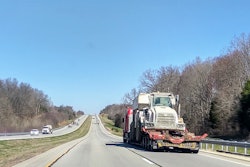The Environmental Protection Agency on Friday unveiled its new CO2-emissions standards for heavy-duty trucks, covering model years 2027 through 2032, with a final rule.
The new emissions standards laid out in the final rule are somewhat more ambitious than those proposed last year. For example, truck manufacturers are afforded more time (2027-2030) before CO2 reductions begin to apply to sleeper-cab tractors, yet on the flipside, stronger CO2 reductions targets are set for 2031 and 2032.
 A fact sheet available via this link laid out CO2 reductions required by the final Phase 3 rule in this table.
A fact sheet available via this link laid out CO2 reductions required by the final Phase 3 rule in this table.
The EPA rule does not specify any particular emissions solution for truck makers in its rules, maintaining its promise of a "technology-neutral" approach. However, it will be difficult for manufacturers to hit emissions benchmarks without sales of either hybrid, battery-electric or hydrogen-electric trucks, many watchers believe.
Notably, in the final rule, EPA charts two different potential technology paths for manufacturers to get there -- a big part of the consternation among trucking interests about the new standards, given one of those projections shows ZEV-sales percentages equal to those in the table above charting CO2 reductions. To wit, that projection is for 25% of sleeper trucks sold as zero-emissions vehicles in 2032.
Both the Owner-Operator Independent Drivers Association and the American Trucking Associations were quick to note their belief that the targets are simply unachievable.
OOIDA President Todd Spencer said the "administration seems dead set on regulating every local mom and pop business out of existence with its flurry of unworkable environmental mandates."
For once, Spencer and ATA head Chris Spear appear to be on the same page. Spear noted ATA opposes the rule in its current form because the post-2030 targets remain "entirely unachievable given the current state of zero-emission technology, the lack of charging infrastructure and restrictions on the power grid. Any regulation that fails to account for the operational realities of trucking will set the industry and America’s supply chain up for failure.”
More industry reactions poured in following this initial report. Access them here.
A report released earlier this month by the Clean Freight Coalition (CFC), an alliance of truck transportation stakeholders whose founding members include the ATA and Truckload Carriers Association, among others, found that the full electrification of the U.S. medium- and heavy-duty commercial truck fleet is a nearly $1 trillion enterprise in infrastructure investment alone: upwards of $620 billion from the trucking industry in chargers, site infrastructure and electric service upgrades. The trillion dollar total doesn't include the cost of the trucks themselves. Unsubsidized, as Overdrive reporting has shown, those costs are currently two times and more, in some cases, higher than diesel counterparts.
[Related: Electric-truck purchase incentives present big challenges for small fleets, owner-operators]
EPA Administrator Michael Regan called the Phase 3 rule "the strongest national greenhouse gas standard for heavy-duty vehicles in history," and claimed, in the long run, it will save fleets costs on fuel expenses. EPA estimates new trucks could save motor carriers upwards of $3.5 billion in fuel and other costs over the six model year period.
New battery standards a part of the rule
The Phase 3 rule is part of the current administration's so-called "Clean Trucks Plan," and follows December 2022 regulations that required very-low nitrogen oxides limits and further particulate-matter reductions by model year 2027.
As noted above, EPA isn't requiring a particular technology to meet the new standards, but the rule makes clear that the agency believes electric trucks will play a significant role.
In addition to the emissions-reduction standards, EPA also institutes battery-durability monitoring and warranty requirements for batteries and other zero-emission truck components.
EPA said that because of the expected increased role of electric trucks in some form or fashion -- battery-electric vehicles (BEVs), plug-in hybrid electric vehicles (PHEVs) and fuel-cell electric vehicles (FCEVs) -- it included “requirements to ensure that such vehicles certifying to EPA standards are durable and capable of providing the anticipated emissions reductions to which they are certified.”
Manufacturers will be required to provide a customer-facing battery state-of-health (SOH) monitor for all heavy-duty BEVs and PHEVs. This monitor will estimate, monitor and communicate the vehicle’s state of certified energy, giving customers an estimate of the truck’s current state of health of the battery, in terms of the state of its usable battery energy (UBE) expressed as a percentage of the original UBE when the vehicle was new.
[Related: Electric trucks don't stand a chance, even in drayage, without more power infrastructure]
“We are finalizing new battery durability monitoring to apply for MY 2030 and later HD BEVs and PHEVs as a key step in assuring the emission reductions projected for this program will be achieved in use,” EPA said.
Manufacturers will also be required to warranty batteries and “emissions-related components.” EPA identified the high-voltage battery and the powertrain components that depend on it (including any fuel-cell stack, electric motors and inverters) as “emission-related components” for the purposes of the rule.
The agency said it believes it has “defined which components are covered, while leaving the requirements general enough to cover technologies that are not currently in the market.” In its proposal last year, EPA received comments asking the agency to also define what failures are covered under the emissions warranty, but the agency decided to leave that up to the manufacturers, “as the current warranty requirements already provide the framework for manufacturers to define the specific failures that are covered under warranty, as they have done for many years.”
EPA is sticking with its proposed minimum warranty periods of 5 years or 50,000 miles for light heavy-duty vehicles and 5 years or 100,000 miles for medium and heavy heavy-duty vehicles. --Matt Cole, Jason Cannon and Todd Dills contributed to this report.
[Related: Top 5 diesel fault codes: Emissions issues you can do something about]








